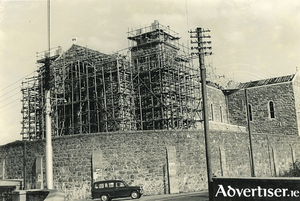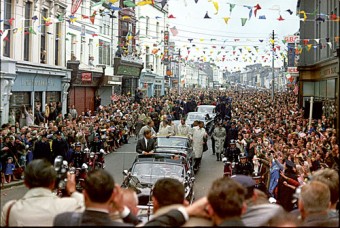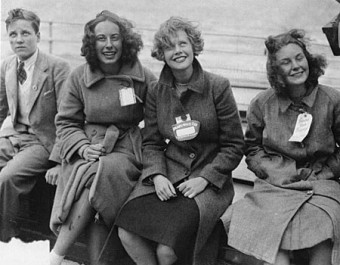Search Results for 'Michael Browne'
19 results found.
Galway Cathedral

“Catholic cathedrals in Ireland are monuments to our imitative instincts and conservative distrust of artistic originality. There are examples of new church architecture but in general, Church authorities remained faithful to the Middle Ages and refused to abandon medieval architecture. It is therefore understandable that in 1949 when the building of Galway Cathedral was commissioned, it should have been conceived in a hybrid Romanesque style. In 1959, the foundation stone was laid and on August 15, 1965, the Cathedral of Our Lady Assumed into Heaven and St Nicholas was dedicated by Cardinal Cushing. In December that year the Vatican Council solemnly ended its revolutionary document The Constitution on the Sacred Liturgy which rendered the shape, style, arrangement, and setting of such buildings obsolete and anachronistic. This building was almost an object lesson in insularity. It is clear from the late Bishop of Galway’s instructions that for him art can be no more than decoration, an illustration of scripture or a clearly formulated theology. Art is never an original source, a spiritual revelation, a doing of theology.”
Patricia’s vocation did not take root

Patricia Burke Brogan joined the noviciate of the Mercy Sisters at the convent of St Vincent, Newtownsmith, Galway at the end of the 1950s. It was before the reforms of Vatican II had relaxed rule of the heavy medieval habit, the shorn hair, and a constant reminder ‘to keep custody of the eyes’. What was called ‘discipline’, which was nothing less than outrageous bullying, was meted out on the novices by some of the older nuns, in a cutting and wounding way. The nuns were hard on each other.
Suspended sentence for man who tried to steal church donations
A man who attempted to cut the lock off a church candelabra with a hacksaw in order to take the donations was given a suspended prison sentence at Ballina District Court this week.
JKF - 50th Anniversary of presidential Visit to Galway

It lasted only an hour, but for a generation of Galwegians it was a momentous occasion, one that gave a city and a population emerging from the oppressive 1950s, a much needed boost of confidence. It was the day US president John F Kennedy came to visit.
The Knights of Malta in Galway

The first unit of the Order of Malta in Galway began in 1937 when Dr Conor O’Malley was asked by the Marquis McSweeney, the then chancellor of the Irish Association, to recruit members to form an ambulance corps aimed initially at Connacht only.
Galway’s ‘splendid human spirit’

The people of Galway were shocked and excited by the arrival of 430 survivors who were brought ashore from the Athenia which was sunk by torpedo off the Donegal coast only hours after war was declared on September 3 1939. The town was galvanised into action. An impressive and practical plan was put into place to receive the survivors, to ensure they were comfortably accommodated, and to care for the wounded. There were 10 stretcher cases, numerous minor injuries, and distressed children. The passengers, who included Americans and Canadians, and refugees fleeing a deteriorating political situation in Europe, were bound for Montreal.
The day war came to Galway

On Monday morning September 4 1939, the Galway harbour master Capt T Tierney was listening to a radio message from the Norwegian freighter Knute Nelson to say that it was steaming to Galway with 430 survivors from the Athenia, which was sunk by torpedo 250 miles north-west of Inishtrahull Island, off the Donegal coast. There were injuries among the survivors. Many were distressed and suffering from hypothermia. It requested urgent assistance.
Mayo’s handballers make a good start in the championship
Mayo handballers fared very well in their opening Connacht 40 x 20 semi-final ties with Sligo opposition over the weekend. George Miller defeated Sligo's Martin Cooney in a thrilling three-game encounter at Castleconnor on a 12-21, 21-7, 21-16 scoreline in the silver masters B singles, while Paschal Tuohy of Mayo had a 21-13, 21-13 win over Michael Browne in the junior C singles at the same venue. Killala's Martin Cronin is also through to the diamond masters A final as he beat Seamus Duffy in two games at St Mary's on Saturday. The only Mayo loss of the weekend was in the ruby masters as John Kenny came out second best against Sligo veteran Paddy Walsh in two games. Mayo host Sligo next weekend in seven doubles semi-finals.
Shantallow House

Our photograph today shows two young girls, Marie Scanlon and her sister from Shantalla, standing in front of Shantallow house in the mid 1940s. Prior to the building of the council houses we know as Shantalla, this house was more or less surrounded by green fields. At one time the house was owned by a distinguished engineer named William Blood, who was related to the Maunsell family from across the road in Fort Eyre. Blood’s nephew was George Johnson Stoney who was professor of natural philosophy in Queen’s College, Galway, from 1853 to 1857, and who lived in this house during that time. He was a distinguished amateur scientist who worked for a time as Lord Rosse’s astronomer at his large telescope in Birr. Stoney was the person who coined the name ‘electron’. He later became the secretary to the Queen’s Colleges, so he made a significant contribution.


